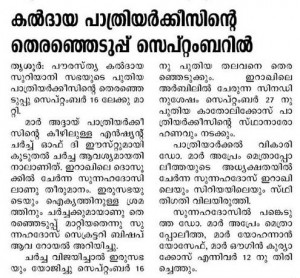ELECTION OF CHALDEAN PATRIARCH POSTPONED. Press Release
Ancient Church of the East
Relationship with the Assyrian Church of the East
The Ancient Church of the East was distinguished by its intent to maintain the traditions passed on by the Church of the East. The schism that divided the Church of the East into two parts resulted mainly from controversial changes introduced by Mar Eshai Shimun XXII. The most obvious of these was the decision to replace the traditional Julian Calendar with the Gregorian Calendar. Additionally, there were concerns raised in regards to the succession of the Patriarchate. The Patriarchate had been hereditary in the d’Mar Shimun family for six centuries, often resulting in the consecration of minors as head of the church. For example, the late Mar Eshai Shimun XXII himself was ordained Patriarch at just twelve years old. [3]
Under the tenure of Mar Addai II, the Ancient Church of the East has made several gestures towards reunification with the Assyrian Church of the East. The most prominent of these is undoubtedly the declaration made in June of 2010 stating that the Ancient Church of the East would now celebrate Christmas on December 25, in accordance with the Gregorian Calendar. Previously, the church recognized January 7 each year as Christmas day, as the Church of the East had for thousands of years. The decision was to be implemented later that year, on December 25, 2015.[4] This was the first time since the schism that the two churches celebrated the Christmas holiday on the same day. Despite this decision, the Holy Synod maintained that Easter would continue to be celebrated according to the Julian Calendar.
The declaration related to the celebration of Christmas was perceived as an attempt of reconciliation, and encouraged efforts for talks of reunification. A joint Holy Synod between the two churches was postponed, though is expected in the near future.
The international Assyrian community has long-since advocated for reunification, particularly in response to the 2014 and 2015 attacks launched against Assyrians in Iraq and Syria, respectively. Since that time, relations between the churches have improved on every level, particularly in the United States, Australia, New Zealand, and parts of Europe.
Churches Resume Dialogue of Reunification
In early May of 2015, following the passing of His Holiness Mar Dinkha IV, Catholicos-Patriarch of the Assyrian Church of the East, dialogue of unification resumed between the churches. Reunification of the two branches of the Church of the East was encouraged by the late Patriarch. Following an informal meeting between Mar Gewargis Younan and Mar Paulus Benjamin, an official meeting request was delivered to His Beatitude Mar Aprem Mooken, acting Patriarch of the Assyrian Church of the East.
On Friday, May 22, 2015, a meeting involving prelates of both Holy Councils took place in a suburb of Chicago, Illinois in the library of St. Andrew’s Assyrian Church of the East. The meeting included His Beatitude Mar Yacoub Daniel, His Beatitude Mar Zaia Khoshaba, and His Grace Mar Gewargis Younan representing the Ancient Church of the East, and His Beatitude Mar Gewargis Sliwa, His Grace Mar Awa Royel, and His Grace Mar Iskhaq Yousif representing the Assyrian Church of the East. Very Reverend Archdeacon William Toma served as the meeting’s common secretary. Mar Yacoub Daniel flew in from Australia specifically for the meeting, and Mar Zaia traveled from Canada.
During the meeting, recommendations for unity between the Ancient Church of the East and Assyrian Church of the East were delivered through the selected representatives of each branch. The primary issues discussed were church leadership and the Holy Calendar. It was decided upon in this meeting that the individual Synods would meet separately to further discuss the terms. Another meeting between the two churches will then be scheduled for a later date and continue negotiations. It was requested by the Ancient Church of the East prelates that the election of the new Catholicos-Patriarch be delayed until negotiations have concluded, in the hopes that a unified Synod would elect a successor together. In the event that the churches agree to reunify, His Holiness Mar Addai II would be expected to resign. The Patriarch has already given his blessings, provided that certain traditions of the Church of the East are maintained, namely the celebration of Easter Sunday in accordance with the traditional Julian Calendar.
On June 1, 2015, the Holy Synod of the Assyrian Church of the East met in Erbil, Iraq to discuss the future of the church. The date had previously been arranged for the election of the new Catholicos-Patriarch. Mar Awa Royel issued a statement on the same day, notifying the public that a response to the Ancient Church of the East’s recommendations for reunification had been delivered to their prelates. The letter requested a prompt response to the terms, and the election of the new Patriarch was suspended until the following week, on June 8, 2015. On June 2, 2015 Mar Gewargis Younan issued a statement on behalf of the Ancient Church of the East stating that a provisional decision had been reached to reunify the two branches. The statement dated June 2, 2015 also indicated that the Holy Synod of the Ancient Church plans to convene in the near future to issue a formal response.
On June 5, 2015, His Beatitude Mar Aprem Mooken issued a formal statement announcing that the election of the next Catholicos-Patriarch of the Assyrian Church of the East was suspended until September 27, 2015, pending the unification of the churches. Deliberations are ongoing.





